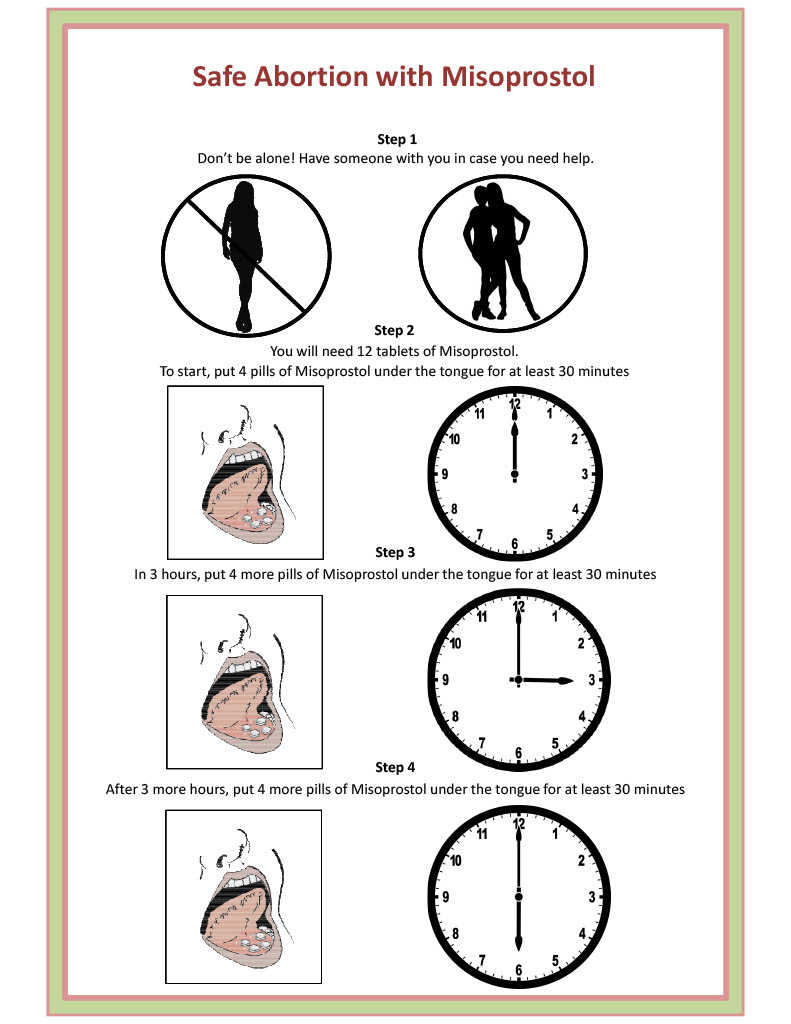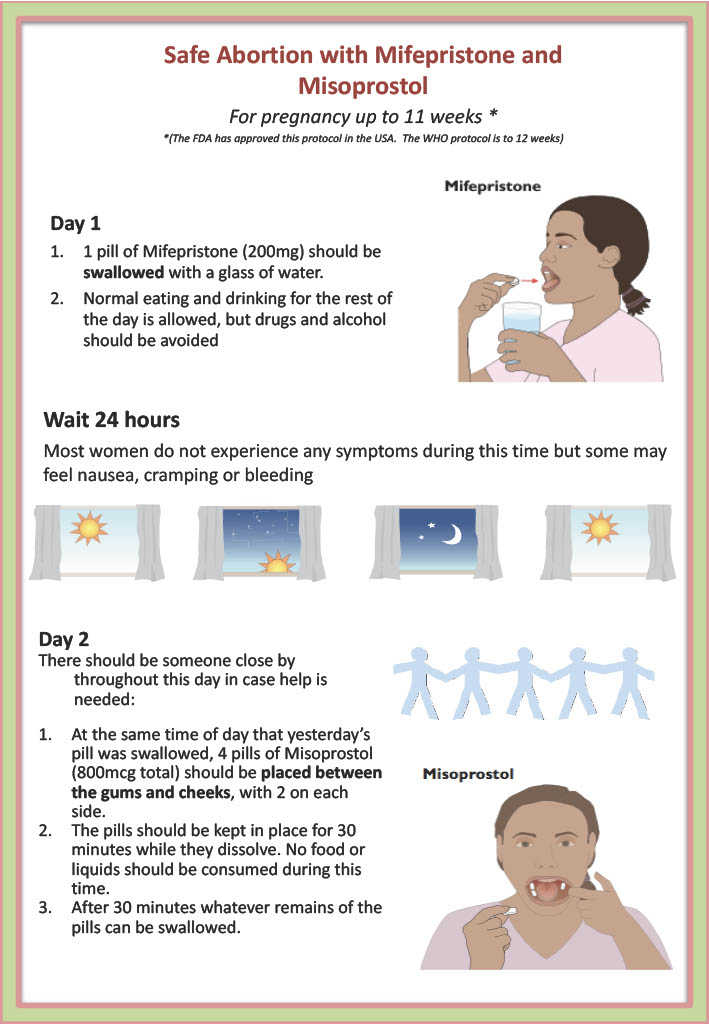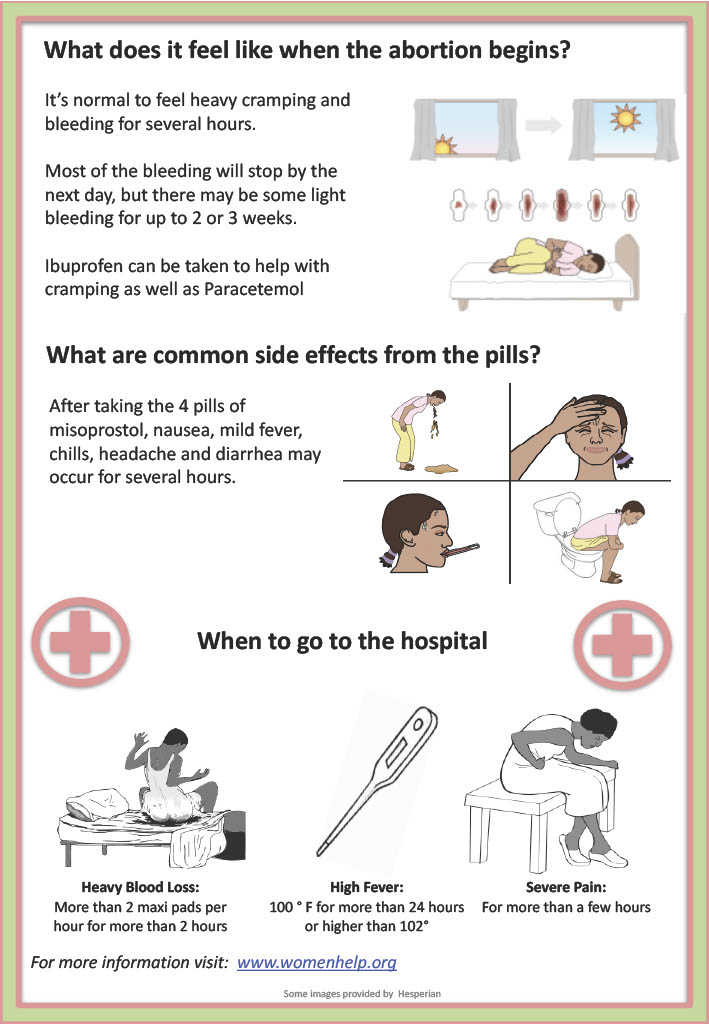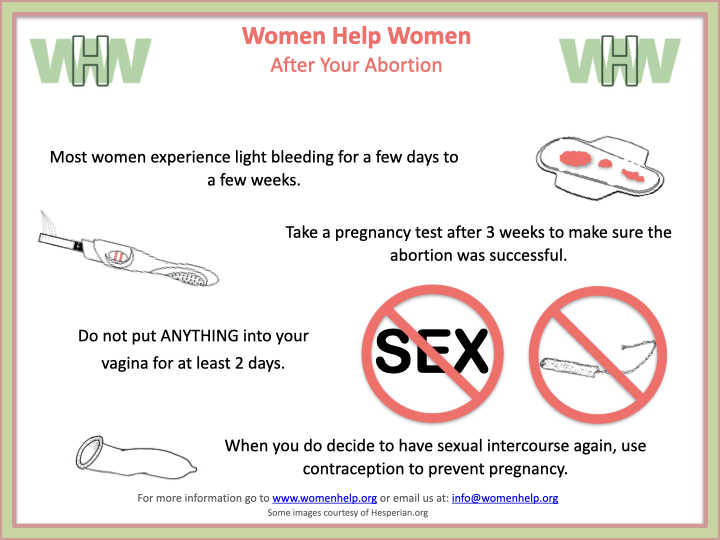How to Use Abortion Pills
Para español haz click aquí English/Español
NOTE: The contents of this website are for informational purposes only and are not a substitute for advice from a medical provider.
Abortion pills are a safe and effective way to end a pregnancy. However, in many states the law requires that abortion pills be given by licensed health care clinicians, and a person who uses abortion pills that were not obtained through a clinician may face criminalization.
Frequently Asked Questions
Misoprostol, used alone or in combination with mifepristone, is a safe and effective way to end a pregnancy in the first 12 weeks. It is approved by the World Health Organization as a safe abortion method for use with or without a clinician and has been used successfully by millions of people around the world.
All of the information in the FAQs is based on protocols developed by the World Health Organization. Please read carefully and contact SASS if you have any questions.
Keep your research about abortion private
Whether you’re making an appointment at a clinic, reading up on how to get and use abortion pills safely, making sure no one can interfere with your plans beforehand, or preventing someone from giving you grief about it after the fact, your reasons for wanting information about abortion are nobody’s business but your own. Keep it that way! Here’s how:
- Use Signal for free, secure texting and phone calls.
- Use Protonmail for free, secure email.
- Use DuckDuckGo for private searches without online tracking.
- Read the Surveillance Self-Defense guide to online privacy. It’s easy to understand and updated regularly with recommendations for the safest online communication tools – and instructions on how to install and use them properly.
- Get free information about the law and self-managed abortion online, by phone, or through a secure form.
- Look up information on the Euki reproductive health app.
Q: When should abortion pills not be used?
A person should not use abortion pills if:
- Someone else is forcing them to have an abortion.
- They are more than 12 weeks pregnant. The instructions on this website follow the WHO protocols for pregnancies that are under 12 weeks from the date of the last menstrual period. The pills are used differently after 12 weeks and this website does not include that information.
- They are allergic to mifepristone or misoprostol.
- They have an IUD (intrauterine device). It should be removed before using the medicines.
- They have any of the following conditions: chronic adrenal failure, hemorrhagic disorders (bleeding disorders/diseases), porphyries, or other serious disease.
- They have an ectopic pregnancy (a pregnancy outside the uterus).
- They cannot get to a hospital or doctor within two hours.
- They are alone. They should ask a partner or a friend to stay with them while they use the medicines.
Q: What is important to know before using the abortion pills?
A person should do these things before using abortion pills:
1. Confirm the pregnancy with a urine test, blood test, or ultrasound.
2. Know the length of pregnancy. This can be best estimated by counting the days since the first day of the last menstruation. To easily calculate the length of pregnancy, use this pregnancy calculator.
3. Make a plan.
It is important to have someone for support and in case of a medical complication, although complications are very rare. It is good to have ibuprofen for the cramps. If a person is nauseated due to pregnancy, they should take an over-the-counter anti-nausea medicine (anti-emetic) to avoid vomiting the pills. Have sanitary pads on hand.
Plan to start the medicines as soon as possible. An abortion with pills at home is safest and most effective if done before 12 weeks of pregnancy.
On the day of taking the medicines, one can eat and drink normally. The medications don't need to be taken on an empty stomach. Avoid drinking alcohol or eating heavy meals while taking the medicines. Be sure to keep the medicines away from children. Find a place near a toilet where there is comfort and privacy.
Think about what day would be most convenient to take the misoprostol (the second pill that provokes cramps and bleeding). A person will want to be in a comfortable place, with privacy if needed, and near a bathroom.
4. Have no serious medical conditions or an IUD. If the person has an IUD, it should be removed before using misoprostol.
5. Be able to get to medical care within two hours in case of an emergency, and make a plan for getting there if needed.
Q: How should misoprostol be used for safe abortion before 12 weeks of pregnancy?
Up to 12 weeks of pregnancy, a person needs a total of 2400 mcg of misoprostol. This is 12 pills of 200 micrograms each (or 24 pills of 100 micrograms each). These pills are taken in three doses of 800 mcg each (4 pills each time).
Step 1
A person should put 4 pills of 200 mcgs (or 8 pills of 100 mcgs) of misoprostol under the tongue and keep them there for at least 30 minutes, or until the tablets are dissolved. They can swallow their saliva, but NOT the pills. After 30 minutes, they can swallow what remains of the pills.
Step 2
After 3 hours, they should put another 4 pills of 200 mcgs (or 8 pills of 100 mcgs) of misoprostol under the tongue and keep them there for at least 30 minutes, or until the tablets are dissolved.
Step 3
After another 3 hours have passed, they should place the last 4 pills of 200 mcgs (or 8 pills of 100 mcgs) under the tongue and keep them there for at least 30 minutes, or until the tablets are dissolved.
In between the doses of misoprostol, a person can eat and drink normally, but they should not drink alcohol, as it is important to pay attention to what is happening.
The success rate of using misoprostol alone is approximately 85-95%. This means that out of every 10 people who use misoprostol correctly, 8 or 9 will successfully have a safe abortion using this procedure.
IMPORTANT: If a person is taking mifepristone plus misoprostol, the pills are used differently. Please read the appropriate FAQ.

Q: How should mifepristone plus misoprostol be used for safe abortion before 12 weeks of pregnancy?
Up to 12 weeks of pregnancy, a person needs 1 tablet of mifepristone (200 mg) and 4 tablets of misoprostol (200 mcg each).
Step 1
The person should swallow one tablet of mifepristone with a glass of water.
Step 2
Between 24 and 36 hours later, the person should put 4 tablets of misoprostol in the cheek between the gum and lower teeth, 2 on each side, and keep them there for at least 30 minutes, or until they are dissolved. The person can swallow their saliva, but NOT the pills. The person should avoid eating or drinking during this time so that they do not accidentally swallow the pills After 30 minutes, the person should swallow any remains of the tablets.
The success rate of using mifepristone and misoprostol together is 95% to 98%. This means that out of every 10 people who follow this protocol correctly, more than 9 will successfully have a safe abortion using this procedure.

Q: What should a person expect after using abortion pills?
Usually, people do not feel anything after taking the mifepristone (the first pill, which is swallowed). A few people have reported experiencing some nausea, dizziness, or very light bleeding.
After taking misoprostol (the pills that are allowed to dissolve in the mouth), a person may initially feel side effects such as a light fever, chills, diarrhea, and/or nausea. These are normal side effects and usually pass within a few hours after using the misoprostol.
The misoprostol will cause cramping and bleeding as the uterus contracts and pushes out the pregnancy. If a person uses mifepristone plus misoprostol, the cramps and bleeding usually start 1 to 5 hours after using the misoprostol, but some people have cramps sooner and some later. If a person is using misoprostol alone, most people will start bleeding within 7 hours, but it may start several hours sooner or later. Everyone’s body is different.
Bleeding is usually heavier than a period and often accompanied by clots. The heaviest bleeding typically occurs 2 to 5 hours after using misoprostol and usually slows within 24 hours, but some people may pass clots days or even weeks later. This is common and is not dangerous as long as there are no symptoms of a complication.
Ibuprofen is the most effective painkiller for cramps, but other NSAIDs like Naproxen and Diclofenac are also effective. It’s important to follow the instructions on the package of painkillers to avoid using more than the maximum recommended dose. Some people also find that a hot water bottle on the belly brings relief.
During and after the abortion, a person should use sanitary pads, NOT tampons. This is to prevent infection and also to make it easier to keep track of the amount of bleeding to make sure it is within safe levels.

Q: What are the symptoms of a complication?
Complications after early medical abortions are rare. They include severe bleeding and infection. A person should go to the doctor or hospital if she has any of these symptoms:
- Severe bleeding that soaks through more than 2 maxi pads an hour for more than 2 hours in a row.
- Severe abdominal pain that isn’t relieved with painkillers or continues for 2-3 days.
- A fever that reaches 102o F at any point, or a fever of over 100o F that lasts more than 24 hours.
- Abnormal vaginal discharge that is an unusual greenish or yellowish color and/or has a strong unpleasant odor.
Any person who knows that someone used abortion medication to end their own pregnancy might feel obliged to report it, though they are generally not required to do so. Therefore, a person who seeks medical attention may not want to say that they used abortion pills. Instead, they can say that they are having a miscarriage.
The symptoms and treatment for complications of a miscarriage are the same as those for complications of medical abortion. Miscarriage occurs naturally in 15-20% of all pregnancies, and all American hospitals can treat any complications of miscarriage. There are currently no tests that can identify the medicines in the person’s blood or urine, so there is no way that a clinician can know that a person has taken abortion pills unless the patient discloses it or has the pills on or in their body (mouth or vagina).
It is important to remember that some people in the United States have faced arrest or jail for ending their own pregnancies. Although abortion itself is legal, people who end their own pregnancies may risk unjustified arrest and imprisonment under laws that require abortion pills to be dispensed by licensed health care workers and that criminalize self-induced abortion. These laws vary from state-to-state. In spite of these laws, any person who is experiencing a rare complication from a medication abortion can seek follow-up care, because all clinicians can treat a miscarriage and cannot detect the pills.
Q: What if there is no bleeding after using the misoprostol?
If a person has no bleeding after 24 hours, has confirmed the pregnancy, and knows that the pregnancy is developing in the uterus (not an ectopic pregnancy), then they can use 800 more mcg of misoprostol (4 tablets of 200 mcg or 8 tablets of 100 mcg) by dissolving the pills under the tongue for 30 minutes.
If the person bled less than their normal menstrual period, if there were no clots, and they think the abortion didn't occur, they can use 400 more mcg of misoprostol (2 tablets of 200 mcg or 4 tablets of 100 mcg) by dissolving the pills under the tongue for 30 minutes. This is the standard treatment for an incomplete miscarriage.
Q: What happens after the abortion?
On average, people bleed for 9-14 days after an abortion with pills. Some people bleed or pass clots for as long as 4 weeks. After the first few days of more intense bleeding, some people will have little or no bleeding, some will have bleeding that stops and starts, and others will have bleeding similar to a menstrual period for several weeks.
Most people are able to tell that the abortion was successful soon after using the medicines, because pregnancy symptoms disappear quickly and/or they might see the embryonic sac. However, even if the person feels they are not pregnant anymore, it is important to make sure the abortion was successful by either doing an ultrasound about 10 days after the medical abortion or taking a pregnancy test 3-4 weeks after the abortion.
Sometimes the pregnancy test is still positive 3 weeks after taking the medicines because the pregnancy hormones are still in the blood. If that happens, the person should wait a few days and then take another pregnancy test, or have an ultrasound.
If an ultrasound shows that a person is no longer pregnant but that there are remains in the womb, AND if there are no symptoms of a complication, there is no need for any surgical intervention (D&C, curettage, scraping). It is advised to wait until the body expels the tissues naturally.
The menstrual period should return 4-6 weeks after the abortion.
Although the person’s menstrual period may not return for several weeks, fertility returns to normal right away. If a person does not wish to become pregnant straight after the abortion, it is important that they start using contraceptives immediately.
Learn more about contraceptive options.

Q: How does a person know that the pills worked?
Most people are able to tell that the abortion was successful soon after using the medicines, because pregnancy symptoms disappear quickly and/or they might see the embryonic sac. However, even if the person feels they are not pregnant anymore, it is important to make sure the abortion was successful. They should either do an ultrasound 10 days after the medical abortion or take a pregnancy test 3 to 4 weeks after the abortion.
Urine pregnancy test: Even though HcG (human chorionic gonadotrophin, the pregnancy hormone) drops rapidly after abortion, this hormone can stay in a person’s body for several weeks after a pregnancy. Pregnancy tests are still inconclusive or falsely positive several weeks after the abortion. As many as 66% of the pregnancy tests done 2 weeks after abortion are positive, even when the person is no longer pregnant. It is better to wait 3 to 4 weeks before doing a pregnancy test to avoid a false positive.
Ultrasound: Although an ultrasound can confirm if the abortion was successful (pregnancy was expelled) right after the abortion, people are advised to wait 2 weeks before having a scan. An early ultrasound may lead to a wrong diagnosis of incomplete abortion and unnecessary vacuum aspiration or curettage. Medical abortion involves a process that can last for several weeks before the uterus is empty, so remains in the uterus are not a sign of an incomplete abortion. There is no need for medical attention if there are no other signs of complication.
Blood pregnancy test: Blood pregnancy tests are a good alternative to ultrasound, especially if it is possible to do two blood pregnancy tests. A person can do a blood pregnancy test when they do the abortion (it can also be done just before or after the abortion) and then repeat the test 4 to 5 days after the abortion. If the level of hormone called HcG decreases, the abortion was successful.
Q: Where can a person find abortion pills?
Abortion in the first 12 weeks of pregnancy can be done safely using misoprostol alone (85-95% effective) or mifepristone plus misoprostol (95-98% effective). Abortion pills cause a miscarriage if used correctly.
In the United States:
- Misoprostol is available in pharmacies with a prescription. Misoprostol is used to prevent ulcers in people with conditions like arthritis that require them to take non-steroidal anti-inflammatory (NSAID) medication long-term.
- Misoprostol is available from some internet veterinary supply stores and veterinarians, as it is used to treat ulcers and arthritis in dogs. It is also used by pet breeders who want to control animal pregnancies.
- Misoprostol is available over the counter in Mexico and many other Latin American countries. In Mexico, it is sold as misoprostol, Cyrux, and Cytotec.
- Online pharmacies in Canada sell misoprostol inexpensively, and there are reports that some may not require a prescription.
- Combination packs of mifepristone and misoprostol together are also available from online pharmacies. An October 2017 study that reviewed abortion pills bought from multiple online sources identified the relative reliability of both the sources and the pills themselves.
- The online abortion pill finder from Plan C offers information about online programs and sites that provide reliable abortion pills, including the cost and estimated delivery time. A person can input their state of residence and search under “self-managed options.” The cost of mifepristone plus misoprostol from these sites currently ranges from $105 to $470.
If someone already has the medicines, SASS counselors are available to provide support before, during, or after using them. A person can also call or text The M + A Hotline, 1-833-246-2632, where trained clinicians can answer questions.
Emotional support is also available through the All-Options Talkline at 888-493-0092 (weekdays 10AM-1AM ET, weekends 10AM-6PM ET).
Q: Where can a person find a clinic or get help paying for an abortion?
Someone who prefers not to self-manage an abortion can still find abortion care at clinics in many states.
AbortionFinder.org and INeedAnA both have comprehensive, up-to-date lists of clinics sorted by state to make it easier to find the closest one. The Plan C abortion pill finder is also searchable by state and lists telemedicine programs that allow someone to see a provider remotely and receive prescribed pills by mail.
A person who needs help paying for abortion care can:
• Ask their clinic for information about whether Medicaid can help cover the cost of abortion in their state. Some of the clinics listed in the resources above may also be able to offer small grants to help pay for care.
• Call the National Abortion Federation's toll-free, multilingual referral and funding helpline at 800-772-9100. The hotline is available Monday through Friday 8AM-7PM Eastern and Saturday and Sunday 8AM-4PM Eastern.
• Contact an abortion fund to request a loan, grant, or other practical support, like a ride and lodging. The National Network of Abortion Funds maintains an online directory of funds across the US, with information about how to contact them, what kinds of support they offer, and how to work with them.
Q: Is it legal to use abortion pills without a clinician?
A small number of people have been unfairly arrested or jailed for using abortion pills that were obtained on their own. In most of these cases, the charges were ultimately dropped or the person was found not guilty. However, the risk of criminalization is a real one. People who self-manage their abortions may risk unjustified arrest and imprisonment under laws that require the abortion pills be given by licensed health care workers and that criminalize self-induced abortion. These laws vary from state-to-state.
In spite of these laws, any person who is experiencing a rare complication from a medication abortion can and should seek follow-up care. That said, there have been cases of people reporting that someone used abortion medication to end their own pregnancy, even though they weren’t required to report it. So the person seeking medical care should be careful not to say that they have used abortion pills. Instead, all they need to say is that they think they’re having a miscarriage.
There is not currently any test that can identify abortion pills in blood or urine. As long as a person doesn’t have the pills on or in their mouth or vagina, there’s no way for a doctor or nurse to know they used the pills at all. Miscarriages happen naturally in 15-20% of all pregnancies, so every hospital in the US can treat them, and the treatment is exactly the same whether the miscarriage is natural or caused by medication.
For more information about legal issues, contact the Repro Legal Helpline.
Q: Where can a person get answers to questions not covered in these FAQs?
You can use our secure contact form to reach our trained counselors, who are available 15 hours a day in several languages, and get a private and secure response within a few hours.